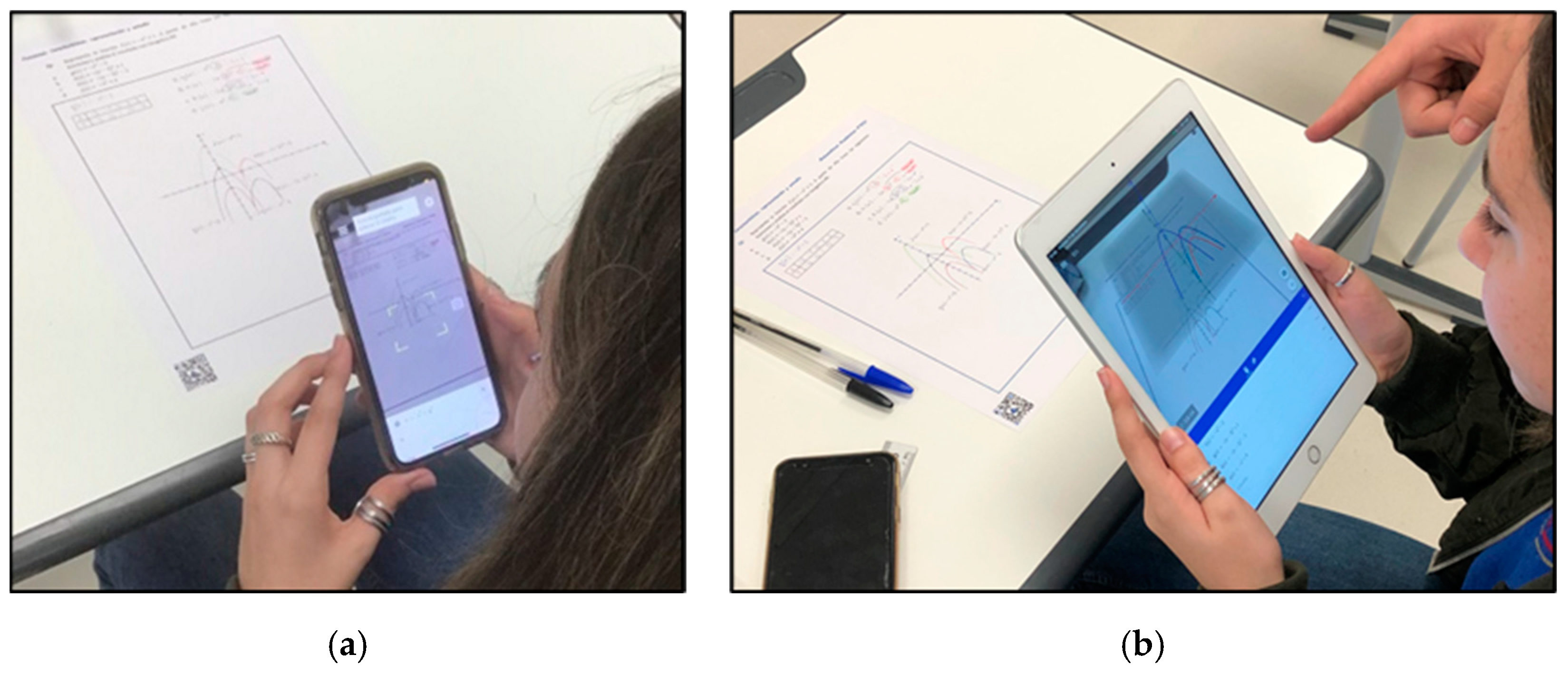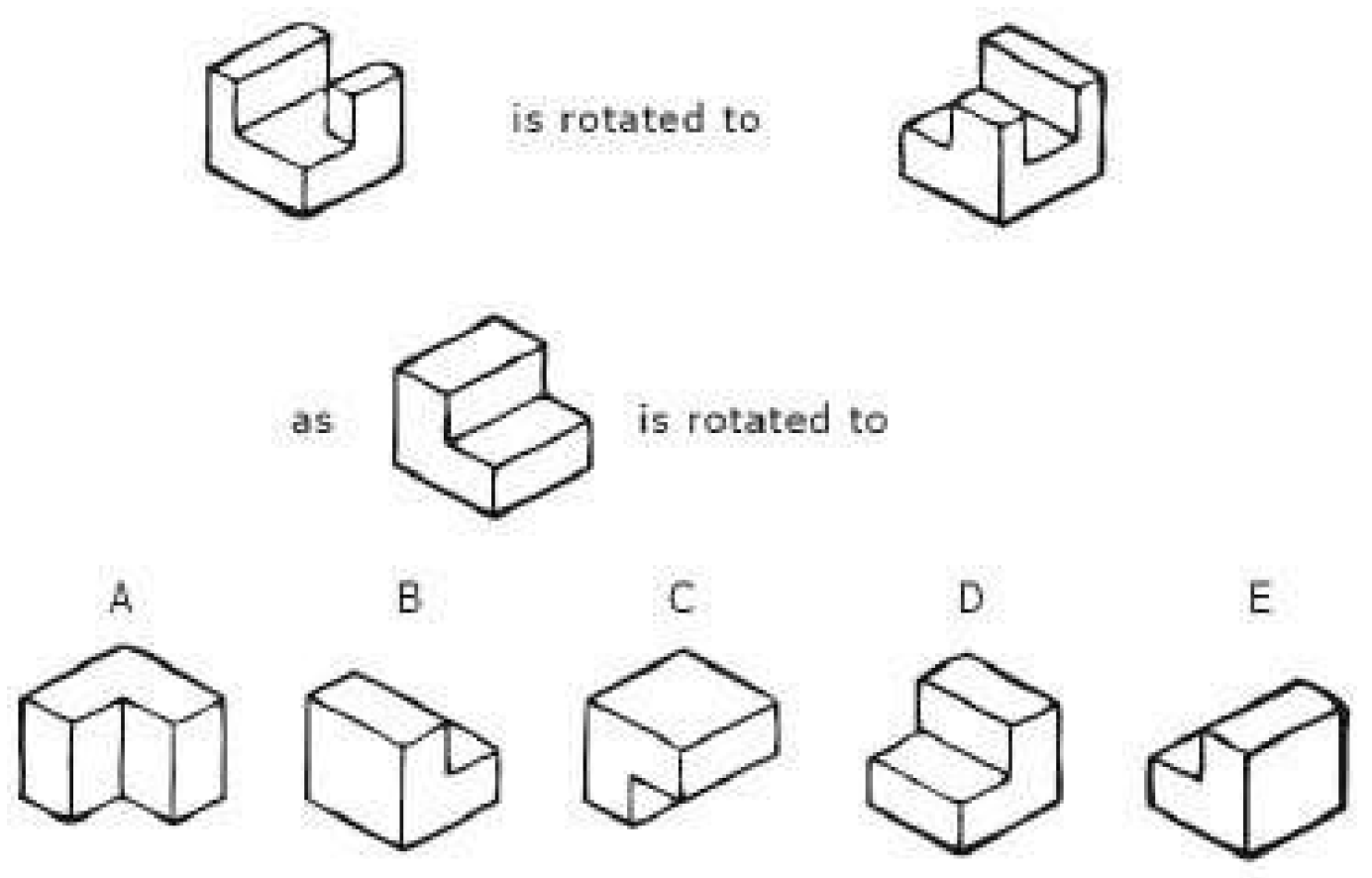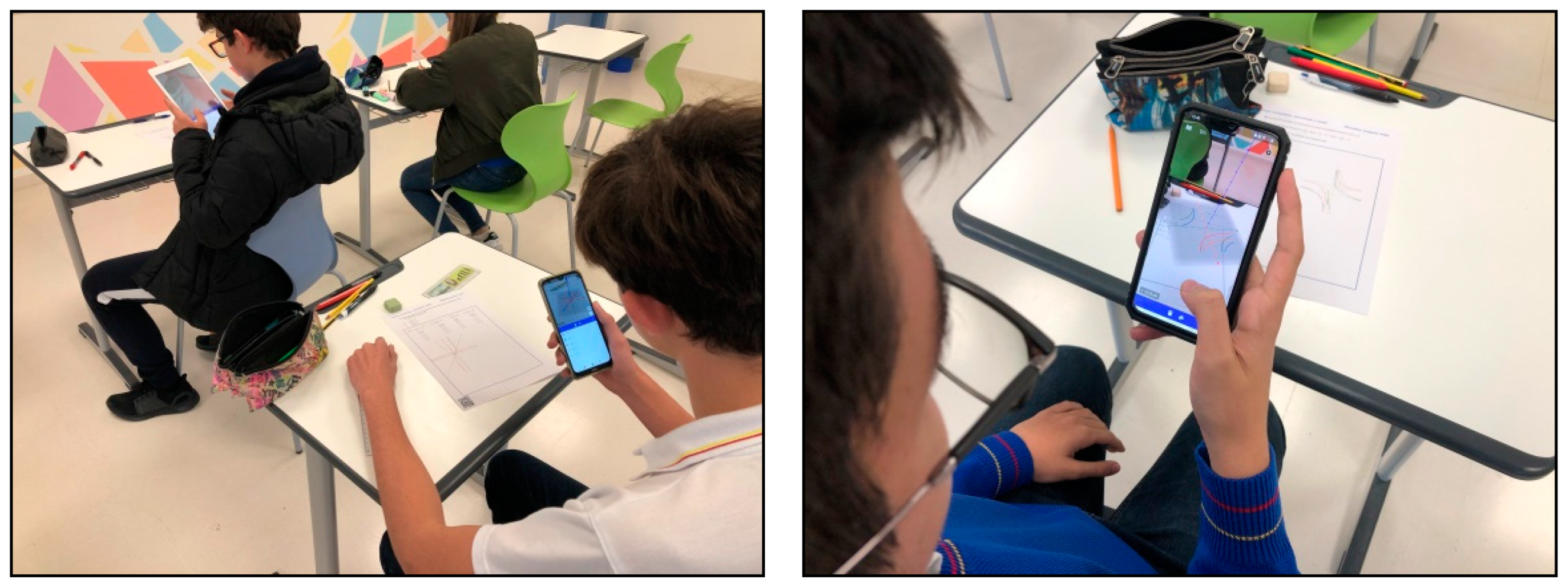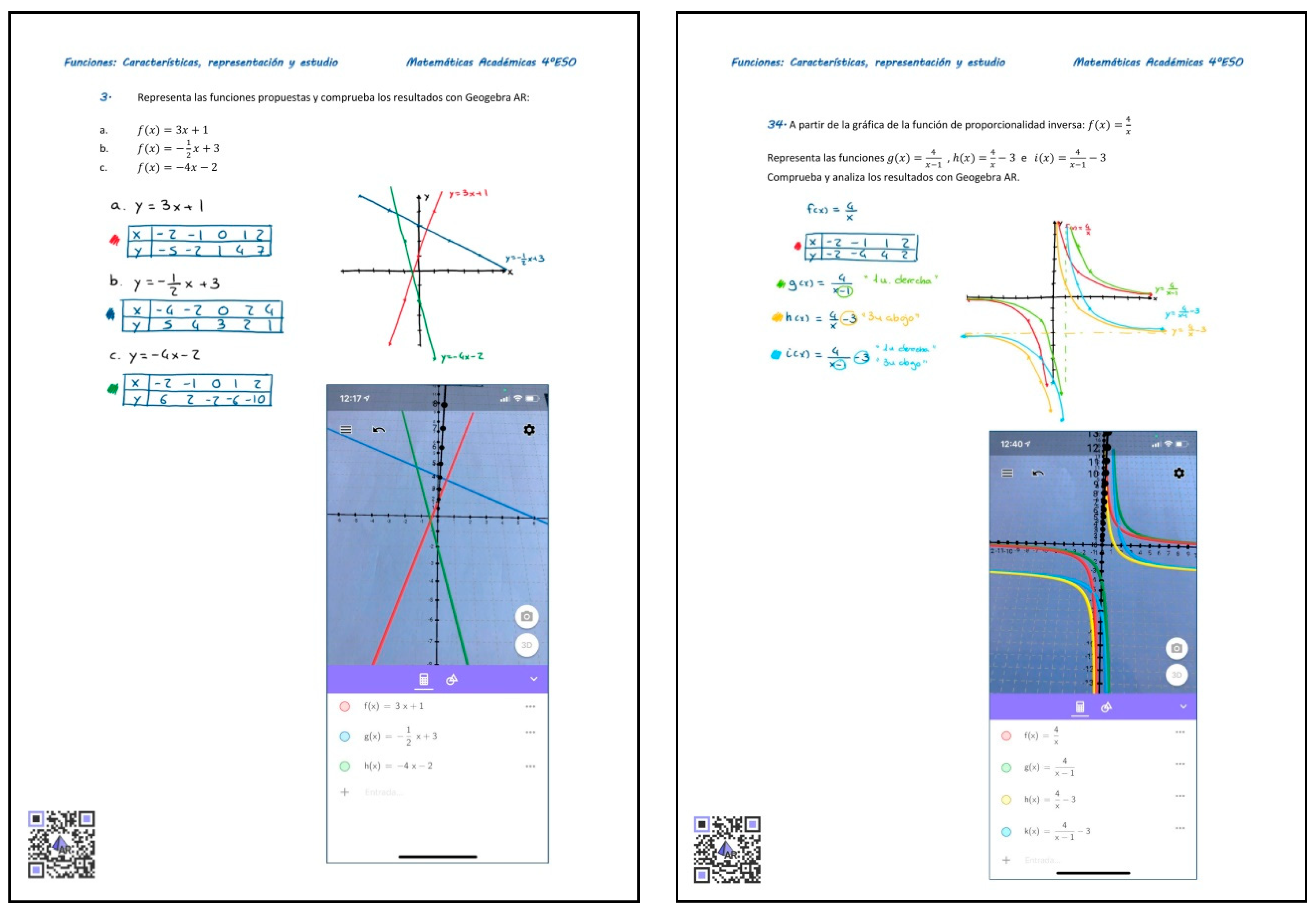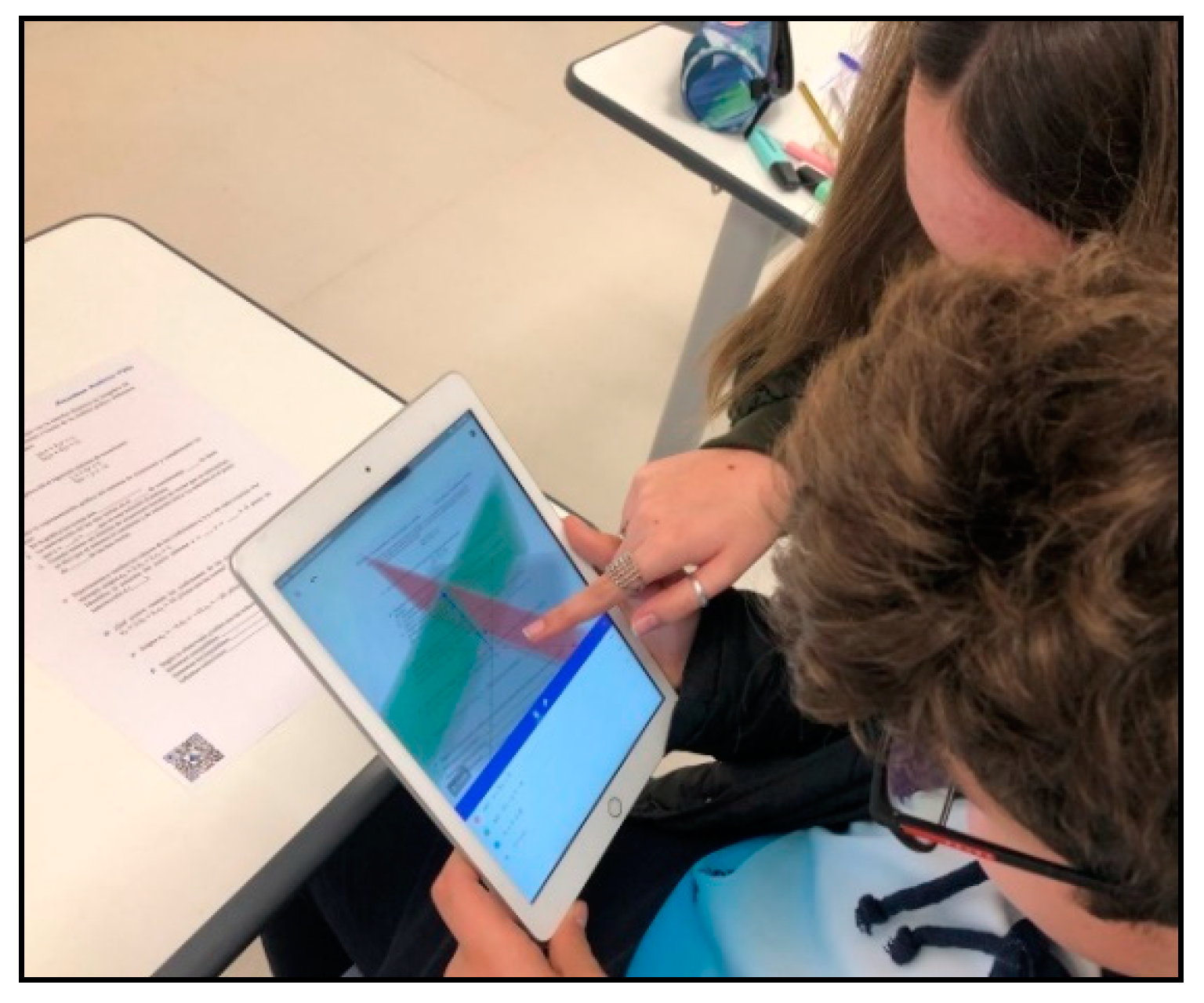The term function in mathematics is defined as any relationship between two or more variables that can be represented graphically. Function learning provides students in Compulsory Secondary Education (ESO) with their first contact with the identification, visualization, and interpretation of the relationship between two independent variables and is therefore a key point of transition within mathematical development figure [
1]. The cognitive transition of graphically representing a constant, linear, affine, quadratic, exponential, absolute value, inverse proportionality, and logarithmic function from its algebraic expression is included in the curriculum of this educational stage and tends to be a challenge for most students.
This study is based on research integrating ICT in the classroom, where we can detect their benefits and drawbacks, design resources to help implement these technological tools, collect and analyze data, and reflect on the results. These action research elements provide a backdrop for teachers to recreate a digital and proactive environment in the classroom within a contextualized methodology that favors the teaching-learning processes of mathematics, with the aim of making students the protagonists in the construction of their knowledge.
Several studies claim that the inclusion of ICT in the teaching and learning of mathematics helps students to visualize how changes in one variable affect others immediately, thus improving their experience and interaction with learning compared to solving formulas so as to obtain the answer [
2,
3,
4,
5,
6]. It is common for students to associate the representation of functions with a collection of isolated points rather than a single entity, making it difficult to visualize and interpret graphically [
7,
8,
9]. As a consequence, students often do not visualize and interpret correctly the representations of graphic functions as a solution in itself, therefore they do not manage to conceive the transition process from algebraic language to visual language and vice versa. Therefore, we pose the following questions: How could ICT based on augmented reality facilitate the process of representation, visualization, and analysis of algebraic functions? Is this cognitive-visual process linked to students’ spatial intelligence?
1.1. Spatial Intelligence
According to Bishop’s theory, an individual acquires the capacity for spatial visualization through three distinct stages of development [
10]. In the first stage, children learn topological spatial visualization, where they can understand the relationship between different objects in space, i.e., the location of an object within a group of objects, the isolation of the object, etc. In the second stage of development, they acquire projective representation, where they can conceive how an object will look from different perspectives. Finally, the final stage of the development of spatial visualization is based on combining spatial projection skills with distance measurement.
On the other hand, spatial intelligence corresponds to one of the eight intelligences of the model proposed by Gardner [
11] in the theory of Multiple Intelligences (MI). This type of intelligence implies having the capacity to perceive the visual world with accuracy, to mentally recreate objects or models, even in the absence of physical stimuli, and to carry out transformations or modifications of them.
In the study of the so-called knowledge areas of Science, Technology, Engineering, and Mathematics, better known by its popular homonym in English as STEM, this type of intelligence is fundamental for students to develop the ability to transfer numerical data and two-dimensional projections to three-dimensional objects with ease [
12,
13]. Within the contents of the subjects of Secondary Education, this skill has numerous applications, such as the conception and construction of spatial models, the analysis of geometric objects, the interpretation of diagrams, and the identification of functions among others.
The term spatial intelligence covers five fundamental skills: Spatial visualization, mental rotation, spatial perception, spatial relationship, and spatial orientation [
14].
Spatial visualization [
15] denotes the ability to perceive and mentally recreate two- and three-dimensional objects or models. Several authors [
16,
17] use the term spatial visualization to indicate the processes and abilities of individuals to perform tasks that require seeing or mentally imagining spatial geometric objects, as well as relating these objects and performing geometric operations or transformations with them.
Shepard and Metzler [
18] define mental rotation as the cognitive ability to rotate ideal representations of dimensional and/or three-dimensional objects or models, and can be described as the movement of representations through the brain to help conceive each of its views or perspectives regarding a turn.
According to Gibson [
19], spatial perception is defined as the ability to visually perceive and understand external spatial information, such as characteristics, properties, measurements, shapes, the position, and movement of an object in relation to an individual.
On the other hand, the spatial relationship determines how an object is located in space in relation to another reference object and this skill is the basis of cognitive development for walking and trapping objects in space [
20].
Finally, we can refer to spatial orientation as a fundamental ability to move and locate oneself in space [
21,
22], being necessary for such common activities as writing straight, reading, differentiating between right and left, and, in general, locating objects and orienting them in space.
These five skills are malleable and can therefore be reinforced through the use of multi-sensory tools or applications that stimulate and improve these abilities [
23]. However, the traditional method for teaching visual and spatial skills to students is based on analyzing and interpreting two-dimensional images, orthogonal views, and graphics on a blackboard or paper. This method has obvious limitations, as it hinders the conceptualization and assimilation of contents due to the lack of interaction between students and the representations [
24].
This study relates the development of spatial skills to the representation of two and three-dimensional functions in mathematics, and demonstrates that augmented reality technology contributes to the improvement of spatial skills and the understanding of highly visual content. This might be due to the observation and experimentation of the models from different angles and relative positions, respecting the individual learning pace of each student. Some studies [
25,
26] state that visual and spatial abilities can be improved by emerging technologies such as augmented reality. The integration of this technology in the classroom favors a constructivist approach to learning by allowing teachers to introduce tangible and proactive experiences in the classroom where students interact and manipulate with the learning object. As educators, we must show a positive attitude towards the integration of ICT in education, as it effectively changes the way students learn [
27], however, a lot of work still needs to be done in order to achieve a systematic development of augmented reality for educational purposes.
1.2. Augmented Reality as a Methologocial Resource in Teaching-Learning Processes
Augmented Reality, AR henceforth, offers multiple benefits that support the teaching-learning process. The applications of AR allow the human-machine interaction to be more natural by enabling the preservation of the user’s environment, providing a real frame of reference which the user can rely on to perform certain actions. This process can be achieved through the superimposition of virtual objects in a real environment. Students can experience the ability to combine their real environment with a virtual one designed, in this case, by themselves.
This technology allows any real environment to be enriched with digital information through the use of a camera and software that in recent years has focused its development on mobile devices which, due to their portability, contribute to off-site learning, where any scenario can be transformed for training purposes [
26,
28,
29].
The reports of New Media Consortium [
30,
31,
32,
33,
34,
35] that identify and describe the trends, challenges, and technological advances in education, estimate that AR technology will be established in secondary and higher education classrooms in the short term as an information access tool that will generate new applications of technology in the learning process.
This indicator, together with the omnipresence of mobile devices, which have become the main tool for accessing information in different formats and in an immediate form, can be used as access portals to Open Educational Resources (OER) that adapt the pace of learning to the needs of each user; it combines an AR-mobile device binomial that equates access to learning opportunities and facilitates the provision of mobile, interactive, individualized, and adapted learning services [
26].
The integration of AR technology into the field of education has enabled an evolution of the educational model. Initially, this technology was used only as a tool for immediate access to digital information, involving students in the theories of behaviorism and objectivism. Recently the applications of this technology are undergoing some changes, with students moving from being recipients to providers of knowledge and the teacher taking on the role of guide and tutor with the objective that students generate knowledge using this technology in an interactive way, where the main theories of this new model are: Cognitivism, constructivism, and constructionism [
36].
The fact that the educational scene is one in which the acquisition of digital competences is particularly relevant must be noted [
37], although the vast majority of technological tools and resources do not promote the same learning opportunities for all. The Sustainable Development Goal 4 aims to ensure inclusive, equitable, and quality education and promote continuous learning opportunities for all. Mobile devices are driving a revolution in education, allowing learners to access learning resources anywhere, anytime. Therefore, the role of mobile learning is relevant, as it has the ability to help break down economic barriers, differences between rural and urban areas, as well as functional limitations. The omnipresence of mobile devices is changing the way people interact with information and their environment. In addition, the continuous improvement of the hardware of these devices and their reduction in cost, positions them as the first tool for accessing the most widespread information worldwide [
26]. Consequently, in order to conduct this study, mobile devices were chosen as the learning platform, since all students had one or had access to them, thus guaranteeing access to training for all students.
Thanks to new technologies, we enter for the first time a place where we interact with real objects and at the same time with virtual ones, which allow us to remember previous learning and restructure our thinking, thus giving meaning to what we perceive from the surrounding world. As Vigotsky [
38] stated, people develop ways of interpreting and strategies to relate to physical and cognitive space in such a way that this type of interaction can be established with tools and systems that provide various types of stimulation, thus it is certain that the use of AR will lead to substantial changes in the way knowledge is accessed, interpreted, and communicated, which must be considered in the field of education [
39].
AR as an integrated technology in teaching acquires a dimension that emphasizes sensory transformation, so if it is integrated into the teaching-learning processes it could promote meaningful and contextualized learning acquired through multiple sensory experiences [
40].
This technology can be used in education to represent 3D models of objects that, because of their size, cost, danger, distance and tangibility, are not within the real reach of students. Moreover, working in contexts with AR, there is a direct interaction with the environment or the object of study, making learning more meaningful.
With the representation of objects in 3D through AR technology we have the freedom of spatial exploration, so students can really perceive and understand space as it is. In addition to spatial perception, students can view models in space and modify parameters that alter their geometry. In this way, the spatial visualization is exercised and they can rotate or flip these representations to visualize each of their perspectives or views, thus promoting spatial rotation. At the same time, and while the user observes the parameters that correlate various objects recreated in space and places the designs in the plane, the skills of spatial relationship and orientation are also developed. With all this, we stimulate, work, and enhance all the fundamental fields of spatial skills established by Maier in 1994 [
14] through a multi-sensorial tool, such as AR and mobile devices.
1.3. Geogebra AR as a Tool to Support the Learning of Mathematical Functions
In accordance with the constructivist theory, it is believed that technology can help students in teaching-learning processes. One of the first technological tools for learning functions is graphical calculators, which emerged as an instrument to enable students to solve systems of equations, represent graphs, and perform other tasks with variables [
41]. Despite their benefits, these calculators have limitations when solving and representing certain expressions due to their small output interface. In addition, they must be implemented cautiously, as many students have difficulties when using symbols, which can be counterproductive and slow down the resolution of operations [
42].
The most recent graphical interfaces offer direct manipulation mechanisms for the representation of mathematical functions, allowing users to interact intuitively and directly in the visualization they are editing, providing immediacy and simplicity when obtaining results, and helping their interpretation and learning. The term direct manipulation describes a style of interaction that stands out for the following characteristics: Continuous representation of objects and actions of interest; change from complex command syntax to manipulation of objects and actions; fast, incremental, and reversible actions that have an immediate effect on the selected object [
43]. Therefore, direct manipulation is, by far, the most common type of interaction in mobile applications, and it is found to a greater extent in AR interfaces, since it provides us with an immediate handling of virtual objects in our real environment.
Numerous research studies claim that didactics through AR applications positively influence students’ attitude and motivation towards learning [
44,
45,
46,
47,
48,
49,
50,
51,
52,
53], providing an active teaching environment where the capacity for enquiry and research is encouraged, while promoting the development of autonomous student work in their learning [
26,
54]. Likewise, several studies state that the correct integration of AR applications in the classroom improves students’ learning results [
55,
56,
57,
58,
59].
Despite the numerous research studies cited on AR resource didactics, few are concerned with the possible impact of AR technology on spatial intelligence [
12,
60] and, thus, there is an interest in conducting research so as to determine if there is a real contribution of AR to the acquisition of spatial skills.
In order to explore the development of spatial intelligence in relation to mathematical learning, our classroom experience revolves around the open source application, Geogebra AR, for mobile devices which helps students learn analysis, geometry, algebra, and calculus. This mathematical application is specifically designed for educational purposes. It allows the dynamic drawing of geometric constructions of all kinds, as well as the graphic representation, algebraic treatment, and calculation of functions in a simple and effective way, which permits us to use it as a support tool for the study, promoting mathematical self-learning. There is a large volume of research that has shown that Geogebra, in its version for personal computers, has been effective for the teaching-learning of mathematics [
61,
62,
63,
64,
65], improving the understanding of abstract concepts and enabling their correlation through a meaningful and effective learning experience.
In its AR version, it allows us to generate 3D objects and mathematical functions, which we can place on an imaginary plane in our real environment (
Figure 1a) and then experiment with them in a tangible way, being able to visualize and rotate them with total freedom, which helps to improve the understanding of the function itself through manipulative learning. The user interface of the Geogebra AR application is direct and intuitive. At the bottom of the screen, it includes a section where we can introduce the algebraic expressions of our naturally defined functions, as they appear in the textbooks or as they are written by the teacher on the blackboard, through a virtual keyboard incorporated in the mobile device, generating immediately the graphic representations of the introduced functions (
Figure 1b).
Through the application menu, located in the upper left corner, we can search and open existing resources, save and share our work, as well as make changes to the program settings (hide or show axes, change the coordinate grid, distances between axes, hide or show descriptions or labels, etc.).
The application design promotes the learning and analysis of mathematical functions, not only generating them in AR, but also emphasizing the cognitive-visual process that occurs when an object is built in space. In particular, introducing the algebraic expression of defined functions, representing them in space and interacting with them in AR, is a major cognitive step in the transition from algebraic expression, through 2D linear designs, to the 3D object representation that covers the five fundamental skills of Maier’s spatial intelligence [
14].
